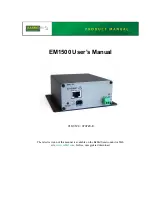
240
Advanced Triggering
You can check the advanced trigger status in the readout. The readout indicates the trigger type
and then shows sources, levels, or any other parameters that are important for the particular trigger
type.
For details on advanced triggers see pages 240–244.
Glitch Trigger
A glitch trigger occurs when the instrument detects a pulse narrower (or wider) than some
specified time. You can set the instrument to trigger on glitches of either polarity or to reject
glitches of either polarity.
Runt Trigger
A runt trigger occurs when the instrument detects a short pulse that crosses one threshold but fails
to cross a second threshold before recrossing the first. You can set the instrument to detect any
positive or negative runt pulse, or only those wider than a specified minimum width. Runt pulses
can also be qualified by the logical state of other channels.
Width Trigger
A width trigger occurs when the instrument detects a pulse that is inside or outside some specified
time range. The instrument can trigger on positive or negative width pulses. Width triggers can
also be qualified by the logical state of other channels.
Transition Time Trigger
Transition triggering is based on the slope (change in voltage/change in time) of a pulse edge. Use
the transition trigger to trigger the instrument on pulse edges that traverse between two thresholds
at faster or slower rates than the specified time. You can set up the instrument to trigger on
positive or negative edges.
Timeout Trigger
A timeout trigger occurs when the instrument does not detect an expected pulse transition within a
user specified period of time, such as when a signal gets stuck either high or low. If the pulse
transition occurs prior to a specified timeout time (the expected case), then no trigger results.
Summary of Contents for TDS5000B Series
Page 36: ...36 AFTDS Differential Signal Adapter...
Page 280: ...280 Blackman Harris window...
















































